
July Eris of the Month 2018: Eris Chaos Magic by bluefluke found on tumblr.
Send us your Eris of the Month Club submissions (more info here) by using the form at the bottom of The MGT. page.

July Eris of the Month 2018: Eris Chaos Magic by bluefluke found on tumblr.
Send us your Eris of the Month Club submissions (more info here) by using the form at the bottom of The MGT. page.
On the same page is what appears to be a short-short by Ray Faraday Nelson who is the author of “8 O’clock in the Morning” a short story later adapted into the paranoid cult classic They Live.
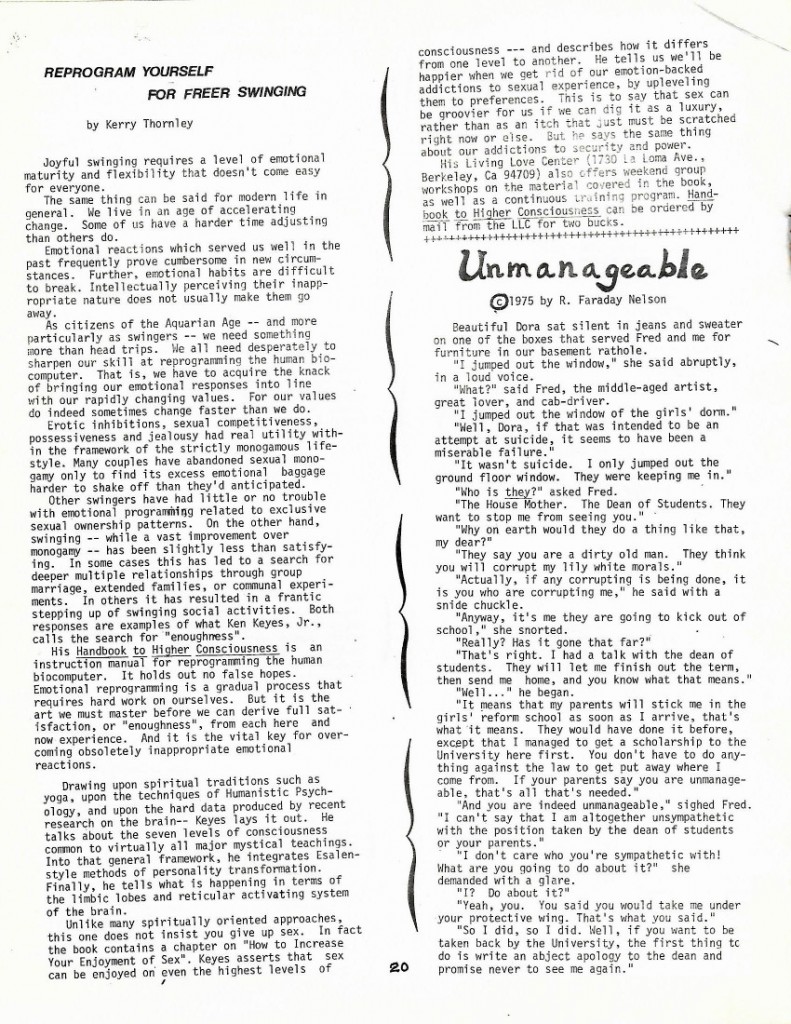

Send us your Eris of the Month Club submissions (more info here) by using the form at the bottom of The MGT. page.

Hey, we even put this calling into the site’s masthead, so, you know, we’re like srsly Discordian zealots.
(DEATH TO ALL FANATICS!)
We enjoy this unique opportunity to have access to both Discordian Founders’ archives as well as other original materials. While Greg Hill and Kerry Thornley kept their stash of documents by very different methods, one Hodge and the other Podge, some clarity has been achieved regarding Discordian history.
Many New Old Truths have been discovered about the origination, growth, hilarity, and impact of Discordianism from this cache of source documents.
As such, we’ve tried to put a little sanity, Goddess forgive us!, on this library of madness:
As we glean new information and post articles about and from the Archives here, we include them into the Discordian Timeline, a linear year-by-year accounting of what was going on and when with the Early Discordians thru to current Modern Discordians.
The Discordian history is a murky maze and fraught with many Erisian contradictions, so we hope offering an understanding of its conception, history, and weirdness on a timeline will help every past, present, and future Discordian Pope better grasp these wonderful absurdities.
And yet more to come!
Check it out and come back for updates:
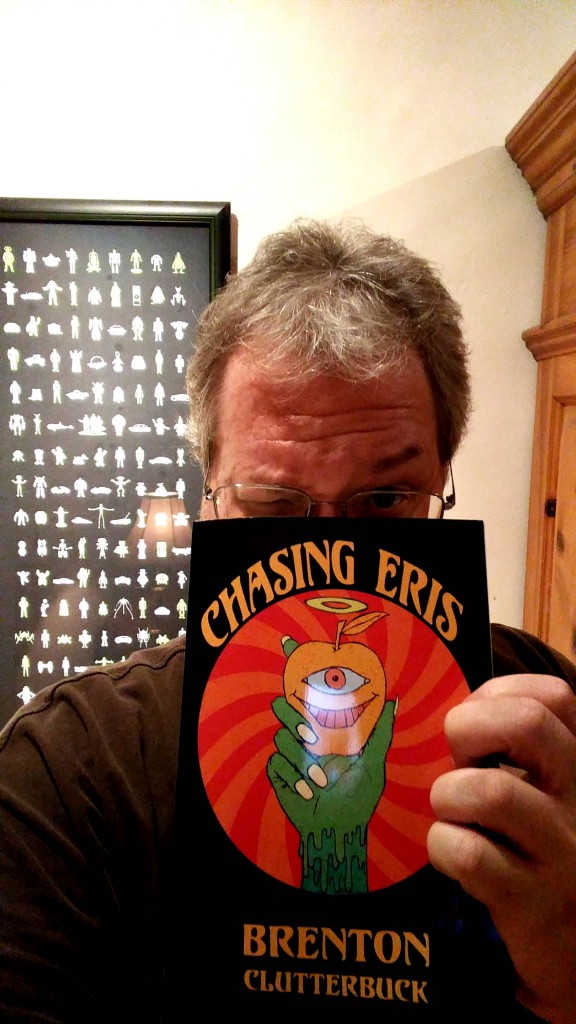
Got my super-duper THICK copy of the Chasing Eris book by Historia Discordia’s very own Brenton Clutterbuck!
All Hail Eris! All Hail Discordia!
Send us your Eris of the Month Club submissions (more info here) by using the form at the bottom of The MGT. page.

Biles’ claimed that Thornley—on account to his supposed CIA affiliations—was well looked after by intelligence agency handlers as payment for his participation with a shadowy New Orleans cabal that conspired to assassinate JFK. According to Biles:
“Garrison investigator Jim Rose would later learn that Thornley had two homes in Florida, one in Miami and one in Tampa, as well as two cars. The Tampa residence, where Thornley lived, was a large white frame house on a one acre lot. Thornley was single and supposedly had only worked as a waiter and doorman at a few apartment houses.” 1
Yours truly has reviewed hundreds of letters in the Discordian Archives dating from the mid-60s until Thornley’s death in the late-90s, and in these letters one can trace his whereabouts and activities, in particular during the Garrison investigation period. Biles’ assertion that Thornley owned two homes in Tampa has no factual basis. Kerry lived on the edge of poverty most of his life (he never owned a house), and was homeless for extended periods. At one time he even made his home in a renovated chicken coop in Tujunga, California.
The only accurate statement—in the above passage from In History’s Shadow—is that Kerry lived in Tampa, and that his employment over the years included jobs as a waiter and doorman. Among other occupations, Kerry edited a Libertarian newsletter, The Innovator, during the mid-60s, in addition to working other odd jobs, including as a dishwasher, a job he performed at a variety of restaurants in Florida and later, Georgia.
Biles maintains that Kerry was single, another glaring goof-up. For the record, Kerry married Cara Leach in Palos Verdes, California in December 1965. They separated in the early 1970s.
Biles’ claim that Kerry owned two cars is also bunk. As was the hippie fashion of the day, he and Cara owned a VW van during the period they lived in Los Angeles, which they later sold to help fund their move to Florida in the autumn of 1967. From that point forward, Kerry never owned another vehicle.
After relocating to Florida, Kerry and Cara—with their infant son, Kreg—lived in an “inexpensive place” in the Palm River District on the outskirts of Tampa, settling there in late 1967 just as the Garrison investigation started heating up. Soon afterwards, they moved to a rented cottage on Marlin Street near the Yacht Club where Kerry worked as a dishwasher. Kerry’s mode of travel at this time was a used $8 bike he purchased from Goodwill. So much for the fantasy he was some sort of well paid CIA super spook. During this period, Greg Hill and Bud Simco visited Kerry in Tampa. According to Simco:
“The only real time we had to visit was while Kerry was at work. So Greg and I went with him and washed dishes at the Yacht Club for free—just to hang out in the kitchen to visit with Kerry… and it was a lot of fun—we did that for a day or two. And the management, they were really amazed that people would do that—these three guys back there washing dishes, two of them for free—all of them, by all appearances, over qualified to be washing dishes… And they couldn’t figure out why Kerry was back there washing dishes because he was obviously a very intelligent person, and they knew he was a writer—basically that’s what Kerry said: “I just want to write—I just want to cover the basic minimum daily requirements, and be left alone to write.” 2
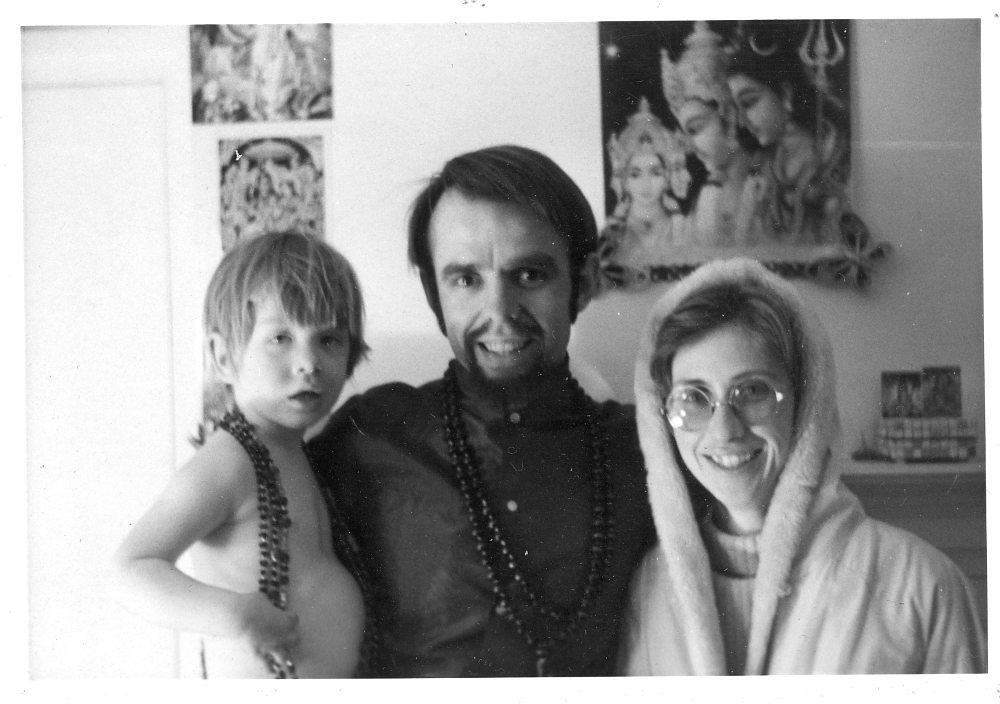
Jim Rose’s entrée into the Garrison investigation came courtesy of former FBI guy William “Bill” Turner, who during this period was freelancing for Ramparts magazine and dabbling in JFK assassination research. At some point, Garrison passed on leads in the case to Ramparts editor Warren Hinkle, which Hinkle passed along to Turner. (Hinkle and Turner would later co-author The Fish is Red: The Story of the Secret War Against Castro (Amazon). Soon after, Turner inserted himself into Garrison’s investigation and brought with him Jim Rose, who had also freelanced at Ramparts.
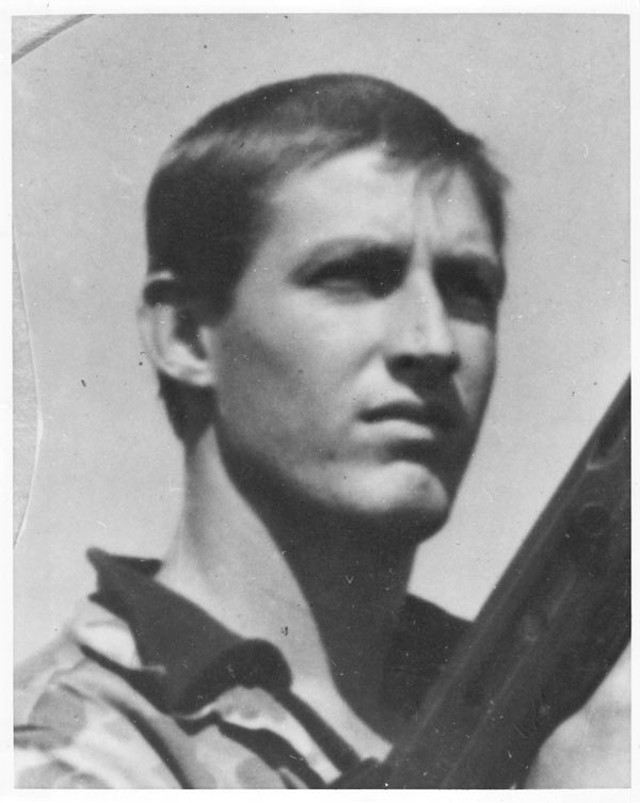
Although Rose used a number of aliases (Jim Rhodes, Vince Rose, Carl Davis and Steve Wilson) his real name was E. Carl McNabb (as far as I’ve been able to ascertain), but for clarity’s sake we’ll just call him “Jim Rose” because that’s how he’s most often identified in memos, letters and articles from the period. According to Warren Hinkle:
“We called him Jim Rose. At least that was the name by which he was known to everyone on the magazine, including one of the secretaries with whom he took up housekeeping between derrings-do. But he had a name for every day of the week. He was Jack Carter when he worked in Miami, until later he became too hot and decided to ‘kill off’ Carter by simulating a plane crash at sea, thus discouraging the spoilsports in the F.A.A. from inquiring further into the checkered history of Carter’s flight plans. He had several newspaper clippings reporting his own death, which he would exhibit with the eager shyness of someone showing you an appendix scar or bottled gallstone. He was also known as Dawes, also as McLeish, also as several other people, among which I was always partial to Rose, because of Gertrude Stein and all. But by any name he was, as Damon Runyan said about those types who stand out among other types of their type, the ‘genuine item.’ He loved adventure, and second only to that he loved talking about adventure.” 3

Although Hinkle considered Rose a real deal soldier of fortune with intelligence agency connections up the wazoo, others connected to the Garrison investigation were less enthralled with the seemingly self created legends swirling around the enigmatic Mr. Rose. Rose claimed he’d worked as a CIA contract pilot, and had flown missions—at one time or another—with one of Garrison’s key suspects, the notorious David Ferrie of red wig fame. However, Rose said many things to many people that more often than not never really panned out. Just the same, there’s plenty of evidence to suggest that Rose was involved in paramilitary activities linked to the CIA.

Strange bedfellows such as Jim Rose suggest that Garrison showed little hesitation about recruiting into his investigation former intelligence agents or assets from the very same agencies that he theorized were behind JFK’s assassination—such “former” agents or assets that could potentially serve as moles and undermine his own investigation. And that’s exactly what Garrison later claimed: that his investigation had been infiltrated by former CIA spies and ultimately sabotaged. In particular, a character named Bill Boxley (aka William Wood), a former CIA spook who—prior to hooking up with Garrison—had apparently been booted from the agency due to frequent bouts with the bottle. Boxley and Garrison eventually had a falling out and Boxley jumped ship and ended up working on Clay Shaw’s defense team.
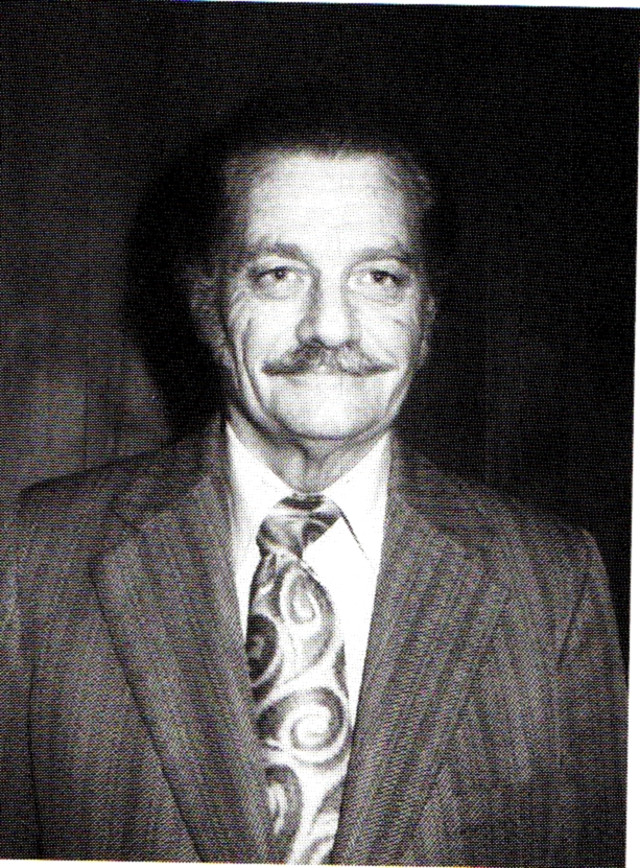
Even though Garrison was knee deep in his belief that the FBI and/or CIA were attempting to sabotaged his case, he nonetheless possessed an almost fan boy fascination with former spooks. The first time Rose met with Garrison at the D.A.’s office, he was frisked by staffer Lou Ivon, who apparently overlooked a deadly ballpoint pen Rose was carrying. “It’s napalm,” Rose explained. “If I shot you, your face would go up in flames.” 4 Garrison endearingly dubbed Rose, “Winston Smith,” then later “Winnie the Pooh,” and “Rosalie.”

Although Rose wasn’t officially on Garrison’s payroll, he was compensated through a slush fund called “Truth or Consequences” that set up by a group of wealthy right wing Garrison supporters. Among his many activities, Rose was paid a thousand dollars upfront to travel to Tacoma, Washington, to investigate Fred Crisman, another among the many colorful alleged JFK assassination conspirators targeted by Garrison.

On a trip in the Northwest in 1968, Fred Newcomb (a JFK assassination researcher and graphic artist commissioned by Harold Weisberg to touch up Kerry Thornley’s photo), spent a couple of days in Tacoma, following up leads on Crisman. While there, Newcomb learned that Rose had been snooping around town earlier that year and making claims that “Chrisman [sic] had been known to transport large sums of money to several cities in the country and that he had no visible means of support.” Rose later claimed that he had been shot at while in Tacoma and barely got out of town alive. 5
As for Crisman’s alleged role in Garrison investigation bingo, he was accused of being one of the three mystery tramps (presumably up to no good in Dealey Plaza) that had been picked up by Dallas cops in the aftermath of the assassination. This was a theory originally promoted by Garrison’s “photographic expert,” Richard Sprague, based on information developed by Jim Rose’s mentor, Bill Turner, and then subsequently “investigated” by Rose.
These allegations against Crisman were later debunked in 1977 by the House Select Committee on Assassinations who determined that—on November 22nd, 1963—Crisman had been filling in as a substitute teacher at Rainer Union High School in Rainer, Oregon, his whereabouts corroborated in affidavits provided by three teachers in attendance that day: Marva Harris, Norma Chase, and Stanley Peerloom. 6
In On the Trail of the Assassins, Garrison spoke glowingly of Rose:
“…an urbane, very bright young man who had grown up in Latin America and spoke Spanish like a native; he was useful in interviews with Cuban exiles… [Rose] was accepted after a strong recommendation from Boxley, who had known him back in his agency days. Rose had a number of photographs showing himself instructing anti-Castro guerrilla trainees at the no name key training camp in Florida back in the early-60s.”
Garrison’s puffery aside, there’s no evidence that Rose actually served with the CIA. According to Big Jim’s glowing prose, Rose had been involved with training anti-Castro exiles, something that Fred Newcomb discovered after coming across a series of photos taken of these training exercises. Newcomb passed the photos along to his circle of assassination researchers that included Penn Jones, Jr., who was able to verify that Rose was indeed the mystery man in the photos identified as “Steve Wilson.” These associations cast a cloud of suspicion over Rose that he had infiltrated the Garrison investigation for dubious reasons.
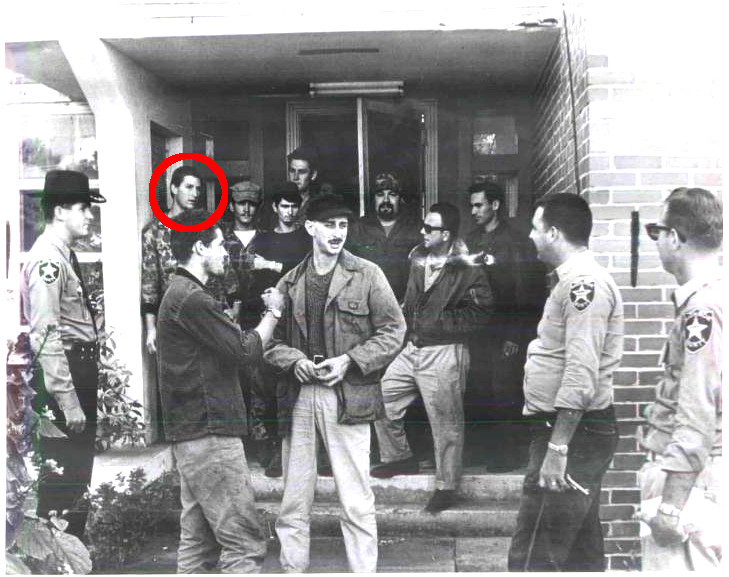
1) Biles, Joe G. 2002 In History’s Shadow: Lee Harvey Oswald, Kerry Thornley & the Garrison Investigation. Writers Club Press. (Pages 66-67).
2) Author’s interview with Bud Simco, Feb 17, 2003.
3) Hinkle, Warren, April 1973, Esquire Magazine, “The Mystery of the Black Books”.
4) Mellen, Joan. 2005. A Farewell To Justice: Jim Garrison, JFK’s Assassination, And The Case that Should Have Changed History. Potomoc Books.
5) “Memo on Jim Rose/Jim Rhodes/Vince/E. Carl McNabb with sidelights on Turner/Jaffee/Crissman/Sprague” by Fred Newcomb (Harold Weisberg archives).
6) Report of the Select Committee on Assassinations of the U.S. House of Representatives. 1979. (Page 607).

Please spread the word on this Indiegogo launch for The Hill and the Hole, a film featuring yours truly as a wise-cracking sociopathic Freemasonic fry dough truck operator and cult leader!
If everything goes as planned, you may even get to see me kill a person or two.
Check out the teaser trailer below and if you are so moved, help any way you can at the film’s Indiegogo page:
The Hill and the Hole | Trailer 1 | 10.31.17 from The Hill and the Hole on Vimeo.
@thehillandthehole on Instagram & Facebook
A teaser for the supernatural independent feature film, The Hill and the Hole, adapted from a Fritz Leiber short story, retold by directors Chris Ernst & Bill Darmon. A weird tale from the southwest. Who would you sacrifice?
Film Score: Drew O'Doherty
Featuring: Liam Kelly, Kristen Brody, Brandt Adams, Adam Gorightly, Chris Dunlop, Matthew O'Donnell, Ricardo Burgos, Xochi, William McLane
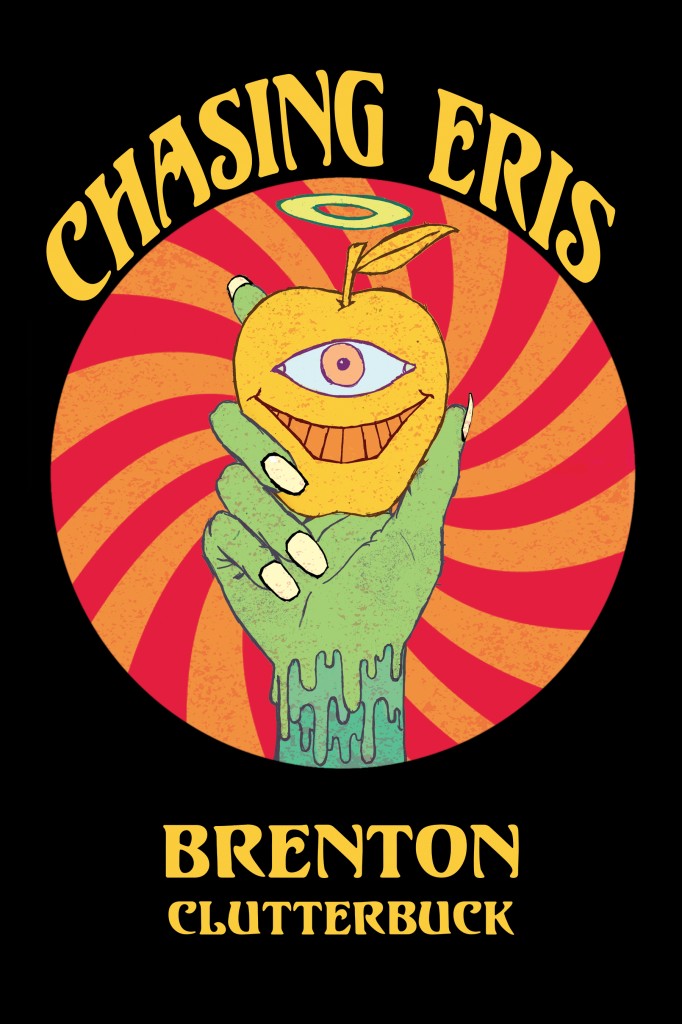
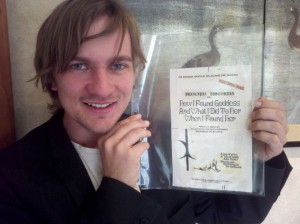
Courtesy of the Discordian Archives.
Go grab your very own copy via Lulu.com immediately.
I asked Clutterbuck for a few of his thoughts on the occasion of the release of Chasing Eris:
After years of horrifying experiments and strongly-worded letters from the Ethics Committee, my secret laboratory has finally produced the most significant marvel of International Chaos Science—my book Chasing Eris.
A note that I am totally wiped-out, weirded-out, and bedazzled by how willing people have been to get excited about this release—it’s very sweet and overwhelming to have my excitement and joy shared by so many of you weirdos, and I hope you know how simply humbled and delighted I am.
I have an e-book and some other tasty treats on the way, and if you’d like notification of when they arrive, you can sign up to my mailing list.
Keep the Lasagna Flying!
Congratulations, Clutterbuck! Eris abides on Chaos well done.
Check out a recent interview with Clutterbuck about writing Chasing Eris, some great deep-mind RAW stuff here:

Get a print copy of April’s Eris of the Month, Hellenic Mythology – Eris, Goddess of Discord by EmanuellaKozas on DeviantArt.
Send us your Eris of the Month Club submissions (more info here) by using the form at the bottom of The MGT. page.
Here are my Five.
Discordian Ritual #1
They can be lump free, chunky, or smooth textured. Many of us perform Discordian Rituals without even knowing. Case in point: as a hirsute, dope smoking teen—long before my Discordian Pope-hood—I oft times visited Fresno’s Fashion Fair Mall, and above the urinal in a restroom there (a urinal can double as an irreligious altar) there was a chalk board with chalk on a string that allowed the user to scrawl lewd crudities as opposed to the walls of the stalls, such as “for a good time call…”
Anyway, with said chalk—and without premeditated thought—I wrote “Jesus is pregnant!”
This was Discordian Ritual #1.

Discordian Ritual #2
My second Discordian Ritual occurred once again in magical Fresno when a colleague and I ingested LSD and went out trippin’ into the streets of our fair city. At some point in our adventure, one of us said: “What if we saw a UFO right now, no one would believe us,” which made us laugh somewhat uncontrollably.
After uttering those immortal words, Eris called down a surreal squadron of psychedelic saucers which blew our minds.
This was Discordian Ritual #2—although I didn’t know I was a Discordian Society member at the time.
Hail Eris!
Discordian Ritual #3
Discordian Ritual #3 was also initiated by psychoactive substances, this time those crazy little mushrooms Eris transported to Earth.
The set-and-setting was out on the beach at Half Moon Bay when the spirit of The Monster Tamer entered my body and gave a blow by blow account of every monster he’d battled and destroyed—from Frankenstein to the Wolfman—to name just a few.
This was Discordian Ritual #3. (You really had to be there.)
Discordian Ritual #4
Discordian Ritual #4 occurred when I lived in an apartment in Clovis, CA, and sculpted a strange bust of a tormented little green creature with pointed ears named GLIB.
When I moved out, I left GLIB in an empty closet alongside a copy of The Book of Mormon, which though I didn’t know it at the time, was a very Discordian thing to do, and may well have lit up the pineal gland of who ever discovered GLIB sharing a closet shelf with Joseph Smith’s holy book.
Discordian Ritual #5
Discordian Ritual #5 actually occurred after I became a Discordian Pope when myself and some friends who didn’t realize they were Discordian Popes—but now understand that they may or may not be—conducted “The Fifth Degree Discordian Initiation Rite” in the parking lot of the fabled Brunswick Shrine bowling alley where Mal and Omar experienced the Revelation of Eris.

So there you have my Five Discordian Rituals.
I could probably name another 23, but not right now fnord.